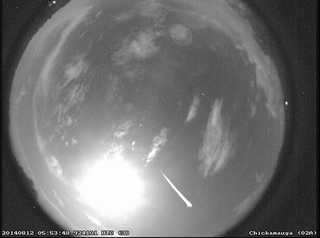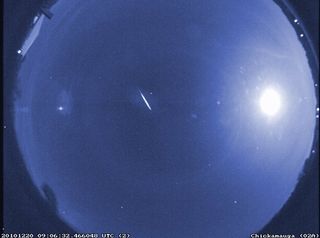Perseid Meteor Shower: NASA Cameras See Early 'Shooting Stars' (Video)
The dazzling Perseid meteor shower has not yet reached its peak, but NASA cameras planted on the ground in the United States have already witnessed some early "shooting stars" streaking across the summer sky.
The 12 cameras in NASA's All-sky Fireball Network captured video of over 110 Perseid meteors associated with the annual August shower, said Bill Cooke of the space agency's Meteoroid Environment Office (MEO) in Huntsville, Alabama.
The cameras can detect meteors as bright or brighter than Mars (with a magnitude of about -2.5) so the network only captures a portion of the fireballs that arc over the Northern Hemisphere during the annual spectacle. With the naked eye, skywatchers can see much fainter meteors.

"The Perseids are one of the best meteor showers of the year — only the Geminids rival them," Cooke told Space.com, referring to another annual meteor shower that peaks in December.
You can watch the Perseid meteor shower live online tonight via two free webcasts by the Slooh Community Observatory and NASA. The first of the webcasts begins at 7 p.m. EDT (2300 GMT) on Slooh's website, http://www.slooh.com. You can also watch the Perseid meteor shower webcasts on Space.com, courtesy of Slooh and NASA.
The Perseid meteor shower occurs each August as Earth plows into bits of debris from the comet Swift-Tuttle. The celestial fireworks are expected to peak tonight (Aug. 12-13), though light from an extra-bright moon, which turned full on Sunday (Aug. 10), has been flooding the sky and it could obscure the reliably brilliant show.
Under good viewing conditions, the shower would typically deliver more than 70 meteors per hour, but this year, skywatchers can expect to see only about 30 per hour, Cooke said.
Get the Space.com Newsletter
Breaking space news, the latest updates on rocket launches, skywatching events and more!
What's more, large swathes of the country have been plagued by cloudy skies in recent days, blocking the view for many of the All-sky Fireball Network cameras. Most are clustered in the Southeast, though there are two in Ohio, two in Pennsylvania and two in New Mexico.

"We know a fair amount about the Perseids, but there's always more to learn," Cooke said.
Editor's Note: If you snap an amazing picture of the 2014 Perseid meteor shower that you'd like to share for a possible story or image gallery, send photos and comments to managing editor Tariq Malik at: spacephotos@space.com.
Follow Megan Gannon on Twitter and Google+. Follow us @Spacedotcom, Facebook or Google+. Originally published on Space.com.
Join our Space Forums to keep talking space on the latest missions, night sky and more! And if you have a news tip, correction or comment, let us know at: community@space.com.

Megan has been writing for Live Science and Space.com since 2012. Her interests range from archaeology to space exploration, and she has a bachelor's degree in English and art history from New York University. Megan spent two years as a reporter on the national desk at NewsCore. She has watched dinosaur auctions, witnessed rocket launches, licked ancient pottery sherds in Cyprus and flown in zero gravity on a Zero Gravity Corp. to follow students sparking weightless fires for science. Follow her on Twitter for her latest project.
